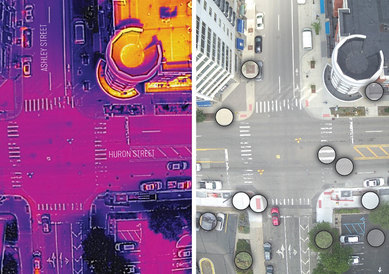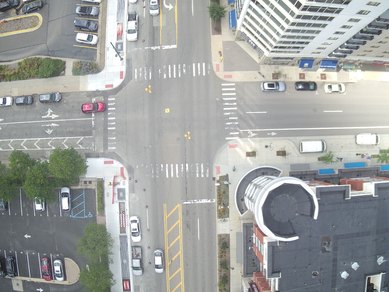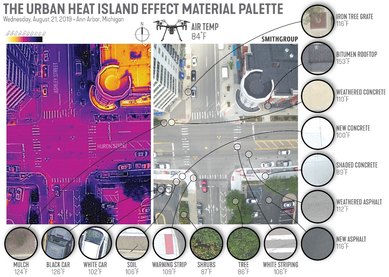利用热成像技术对抗城市热岛效应之五
In Part 4 of this series we sculpted the temporal ‘shape’ of a day in the urban heat island effect. In Part 5 we dissect and inventory the thermal material palette of the urban environment.
Just joining the conversation? The following links are a great place to start: Part 1, Part 2, Part 3, and Part 4.
UNDERSTANDING HOW MATERIALS IMPACT THE URBAN HEAT ISLAND EFFECT
Have you ever wondered what materials make the urban environment feel hotter, or hotter than green space? In the built environment people often overlook the specific materiality of their sidewalks, buildings, and roads. Infrastructure materials fall into the background, they are underfoot and can seem redundant in day-to-day life. But these materials are singlehandedly responsible for both causing- and mitigating the urban heat island effect.
To explore this further I combed the project corridor for a more micro, human-scale snapshot that could be representative of the breadth of the typical urban material palette. The intersection above captured a relatively holistic spectrum of what the public typically encounters, from a material standpoint, within the urban environment.
The graphic above functions as a thermal material palette of the urban environment, and the urban heat island effect. There are no doubt additional items that could be added and explored, but in its barest urban snapshot form we are able to thermally glimpse a lot of what is happening, and where it is occurring. The biggest takeaways:
- Shaded concrete measured within 5°F of the air temperature while exposed concrete averaged 20°F warmer. The shaded concrete was shaded by existing deciduous trees, with exposed concrete measuring upwards of 20°F warmer just a few feet away. Another interesting trait was the difference between new concrete and weathered concrete: new concrete’s brighter surface averaged 10°F cooler than weathered concrete. It would be interesting to compare concrete mixes of the weathered concrete’s original installation with the new sidewalk’s concrete mix. This time next year there will be a opportunity for a lot of these types of comparisons after construction of the new streetscape.
- The black bitumen rooftops measured >150°F. If you have been following this series it is déjà vu all over again. Steak is considered cooked ‘rare’ at about 120°F, ‘medium’ at 140°F, and ‘well done’ at 160°F. In the culinary world, much of our cities would be cooked ‘medium well’ every day all summer.
- Cars lighter in color measured >20°F cooler than black cars. I like black cars. I have owned black cars with black interior. Also, the cars I measured were parked which certainly impacts temperature readings, and with a relatively small and ephemeral urban footprint I am not sure how much their surface actually contributes to the urban heat island effect, but it was an interesting finding. Personally, I have noticed how much hotter the interior of a black car can become on a sunny day, and suspect the resources to cool it down – the engine, air conditioning, fans, subsequent exhaust etc – are significantly increased as a result of basic color options.
This is the fifth installment of what will continue to unfold in coming months and years as data and forthcoming analyses reveal more. Want to see more? Follow SmithGroup on LinkedIn and Twitter to be part of the conversation.



